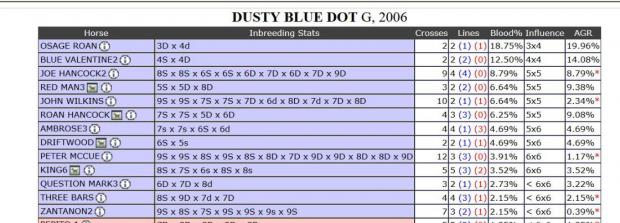I certainly didn’t write the book. I have read plenty who have. Some of which I have found holds true and a lot of which doesn’t IME as a breeder. of TBs.
“Absolutely, it is genetic.”
Well, IME yes and no. IMO and experience absurd to make such a broad statement as fact.
Out of curiosity, to those that have commented. How many horses have you bred? How many in any given year? How many different broodmares have you worked with over the years? If you have only had 1-2-3+ in your broodmare band IMO that is a very small “study” group.
In the grand scheme of commercial TB breeding my operation was on the small side of things. 10 to 20+ foaling mares. A number of which I worked with for years. All by and large were bought at auction. So it’s not like we can spend time with them so as to get a handle on their temperament. Having over 40 years of inspecting 1000s foals, yearlings, older horses. Countless stallions. Studying pedigrees closely, keeping tabs on how the progeny perform. One gets a pretty good inkling into what may or may not be the end result. But that’s about it, an inkling.
In my small personal broodmare band. I have had mares that were at TOTAL PITA to work with. None of their foals turned out to be like them. I have bred to stallions that get good foals, good runners but have a perceived knock about their temperament. I learned not to worry too much about that. IME it is ALL about how they are raised. Being small on a tight budget I did not have the luxury of having lots of staff. All of my foals and clients had my direct attention and handling by and large.
IME I agree with this comment by Beowulf;
“But life, nurture, and environment all play a huge part in how that foal develops and can influence or override their basic disposition. I have often wondered how different some of my horses would have been if I had raised them, or if the circumstances surrounding their nurture had been different”
IME I have not found this to be true as a rule. IMO too many variables.
“Foals also get a lot of education from the horse[s] that raise them. It is very well documented that a foal will base many of its behaviors on what is expressed in its dam, surrogate dam, or “caretaker” horse. So if the foals dam is flighty or spooky, the foal will often piggyback on these behaviors and learn to perceive certain things as worthy of being flighty or spooky from. From that same example a foal that has a laid-back mare that often does not stop to inspect things, will often also demonstrate that same laid-back attitude since the mare did not “teach them” to be alarmed about new things”
In the TB breeding world the foals are weaned by and large at 5 months. In the grand scheme of things a very small part of their life. I could see this holding more water for a breeder that has only 1 or 2+ foals. Our mare and foal fields had LOTs of foals with mares. The foals interacted FAR more with each other then their dams. When a couple of months old they generally all hung and played together. Their dams would be on the other side of the field at times. Some foals would spend more time around another mare with a friend. I guess they, like some of us as kids, found their moms to be more fun, nicer to spend time with?
Unlike a lot of stuff I read, books and or comments in this forum I have not found it necessary to spend a lot of time interacting with foals, weanlings. short yearlings. IME I have found foals tend to get annoyed with too much human interaction, I interact just enough for them to understand humans are a good thing to be around. But never so much as to annoy them and make them standoffish. “Less is more” IME. IMO too many people go by the book, good intentions can and do confuse horses IME.
I have had weanlings, short yearlings sent to me by small breeders, very small breeders. Very nice people. Their horses were always a PITA. When asked about my boarding/training rates I the basic rate is X. Special needs requires special pricing. I would let them know what that price would be after a couple of days a week or so. If they didn’t want to pay it, fine come and get the horse. I only charged extra for the time it took to turn the horse around. I never had a dissatisfied client who paid the extra charge.
I have taken weanlings out of the their field 6 weeks before sending them to a sale. The hardest part was getting them from the field to the barn. Second hardest part was catching some in their stalls. 6 weeks later they walk on the van go to the sale and show like champs to potential buyers.
I’ve had sweet foals that became PITAs after weaning. Had sweet weanling who were PITAs as yearlings for a while. Ones that I was REALLY not looking forward to breaking/starting. Bit of a PITA when first starting the process but came around in short order and more then pleasantly surprised. Thanks god, lol.
So, IMO and experience until you have worked with lots over the years. Take everything you read, hear, are told with a grain of salt. In the world of horses there are just too many variables.
Breeding theories are just that. Theories. Nothing by and large IMO and experience is written in stone. Over the years a lot of things I was told, taught growing up around horses and in the business of horses I have changed modified.
As always to each their own.


